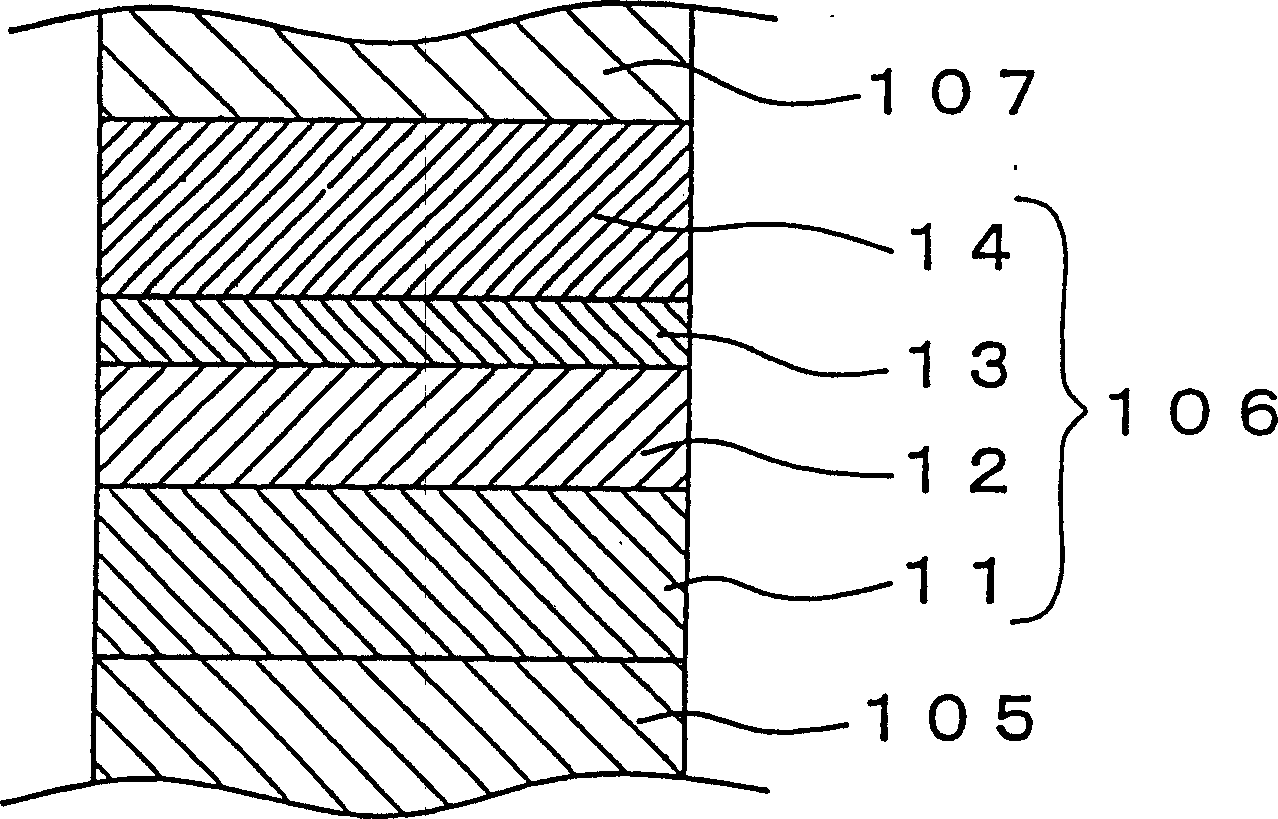Light-emitting device
A technology of light-emitting elements and active layers, which is applied to electrical components, laser components, lasers, etc., can solve problems such as poor surface conditions, and achieve the effect of improving crystallinity
- Summary
- Abstract
- Description
- Claims
- Application Information
AI Technical Summary
Problems solved by technology
Method used
Image
Examples
Embodiment approach 1
[0047] figure 1 This is a model structure showing Embodiment 1 in which the present invention is applied to a light emitting diode. In the light-emitting diode of the first embodiment, a buffer layer 102 , an undoped GaN layer 103 , an n-type contact layer 104 , an n-type cladding layer 105 , an active layer 106 , and a p-type cladding layer 107 are sequentially stacked on a substrate 101 . , and the p-type contact layer 108, and on the n-type contact layer 104 and the p-type contact layer 108, respectively, an n-electrode 111 and a p-electrode 112 are formed.
[0048] The substrate 101 is used to grow a desired nitride semiconductor layer (In x Al y Ga 1-x-y N, x≥0, y≥0, x+y≤1) can be appropriately selected. The buffer layer 102 is to relieve the substrate 101 and the nitride semiconductor (In x Al y Ga 1-x-y N, x≧0, y≧0, x+y≦1) is a layer formed due to an incorrect lattice constant. The undoped GaN layer 103 is a layer formed to improve the crystallinity of the n-typ...
Embodiment approach 2
[0084] Next, a light-emitting diode according to Embodiment 2 of the present invention will be described.
[0085] As described above, the present invention is very suitable for a multiple quantum well structure because the crystallinity of the layers formed above the well layer 12 and the first barrier layer 13 can be improved.
[0086] That is, the light-emitting element according to Embodiment 2 of the present invention adopts the Figure 5 The shown active layer 106c of the multiple quantum well structure has the same structure as that of the first embodiment except that the light-emitting diode is constituted instead of the active layer 106 of the light-emitting element of the first embodiment.
[0087] In the light-emitting element of the second embodiment, as Figure 5 As shown, in the active layer 106c of the multiple quantum well structure, the second barrier layer 11, the well layer 12, and the first barrier layer 13 are sequentially and repeatedly formed. In this ca...
Embodiment approach 3
[0096] Hereinafter, a light-emitting element according to Embodiment 3 of the present invention in which the present invention is applied to a laser element will be described.
[0097] Figure 8 It is a schematic diagram showing the structure of a nitride semiconductor laser element as a light-emitting element according to the third embodiment.
[0098] In the nitride semiconductor laser device of the third embodiment, a buffer layer 202 , an n-type contact layer 203 , an n-type cladding layer 204 , an n-type light guide layer 205 , an active layer 206 , and a p-type light guide layer are sequentially stacked on a substrate 201 . layer 207, p-type cladding layer 208, p-type contact layer 209, and n-electrode 211 and p-electrode 212 are formed on n-type cladding layer 204 and p-type cladding layer 208, respectively.
[0099] The structure of the substrate 201 , the buffer layer 202 , the n-type contact layer 203 , and the n-type cladding layer 204 is the same as that of the fi...
PUM
 Login to View More
Login to View More Abstract
Description
Claims
Application Information
 Login to View More
Login to View More - R&D
- Intellectual Property
- Life Sciences
- Materials
- Tech Scout
- Unparalleled Data Quality
- Higher Quality Content
- 60% Fewer Hallucinations
Browse by: Latest US Patents, China's latest patents, Technical Efficacy Thesaurus, Application Domain, Technology Topic, Popular Technical Reports.
© 2025 PatSnap. All rights reserved.Legal|Privacy policy|Modern Slavery Act Transparency Statement|Sitemap|About US| Contact US: help@patsnap.com



